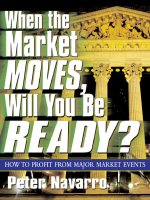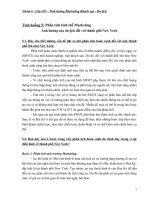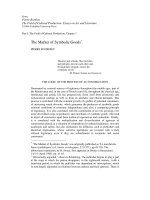the little book that beats the market
Bạn đang xem bản rút gọn của tài liệu. Xem và tải ngay bản đầy đủ của tài liệu tại đây (1.52 MB, 178 trang )
The Little Book
That Beats the Market
Joel Greenblatt
John Wiley & Sons, Inc.
12949 Greenblatt ffirs.f.qxd 10/7/05 8:50 AM Page iii
12949 Greenblatt ffirs.f.qxd 10/7/05 8:50 AM Page ii
The Little Book
That Beats the Market
12949 Greenblatt ffirs.f.qxd 10/7/05 8:50 AM Page i
12949 Greenblatt ffirs.f.qxd 10/7/05 8:50 AM Page ii
The Little Book
That Beats the Market
Joel Greenblatt
John Wiley & Sons, Inc.
12949 Greenblatt ffirs.f.qxd 10/7/05 8:50 AM Page iii
Copyright © 2006 by Joel Greenblatt. All rights reserved
Published by John Wiley & Sons, Inc., Hoboken, New Jersey
Published simultaneously in Canada
No part of this publication may be reproduced, stored in a retrieval system, or trans-
mitted in any form or by any means, electronic, mechanical, photocopying, record-
ing, scanning, or otherwise, except as permitted under Section 107 or 108 of the
1976 United States Copyright Act, without either the prior written permission of
the Publisher, or authorization through payment of the appropriate per-copy fee to
the Copyright Clearance Center, Inc., 222 Rosewood Drive, Danvers, MA 01923,
(978) 750-8400, fax (978) 750-4470, or on the web at www.copyright.com. Requests
to the Publisher for permission should be addressed to the Permissions Department,
John Wiley & Sons, Inc., 111 River Street, Hoboken, NJ 07030, (201) 748-6011,
fax (201) 748-6008, or online at />Limit of Liability/Disclaimer of Warranty: While the publisher and author have used
their best efforts in preparing this book, they make no representations or warranties
with respect to the accuracy or completeness of the contents of this book and specif-
ically disclaim any implied warranties of merchantability or fitness for a particular
purpose. No warranty may be created or extended by sales representatives or writ-
ten sales materials. The advice and strategies contained herein may not be suitable
for your situation. You should consult with a professional where appropriate. Nei-
ther the publisher nor author shall be liable for any loss of profit or any other com-
mercial damages, including but not limited to special, incidental, consequential, or
other damages.
For general information on our other products and services or for technical support,
please contact our Customer Care Department within the United States at (800)
762-2974, outside the United States at (317) 572-3993 or fax (317) 572-4002.
Wiley also publishes its books in a variety of electronic formats. Some content that
appears in print may not be available in electronic books. For more information
about Wiley products, visit our web site at www.wiley.com.
ISBN-13 978-0-471-73306-5
ISBN-10 0-471-73306-7
Printed in the United States of America
10 9 8 7 6 5 4 3 2 1
12949 Greenblatt ffirs.f.qxd 10/7/05 8:50 AM Page iv
To my wonderful wife, Julie,
and our five magnificent spin-offs
12949 Greenblatt ffirs.f.qxd 10/7/05 8:50 AM Page v
12949 Greenblatt ffirs.f.qxd 10/7/05 8:50 AM Page vi
Contents
Acknowledgments ix
Foreword by Andrew Tobias xiii
Introduction xvii
Chapter One 1
Chapter Two 8
Chapter Three 16
Chapter Four 26
Chapter Five 37
Chapter Six 48
Chapter Seven 58
Chapter Eight 67
Chapter Nine 77
Chapter Ten 88
12949 Greenblatt ftoc.f.qxd 10/12/05 9:43 AM Page vii
Chapter Eleven 100
Chapter Twelve 110
Chapter Thirteen 121
Step-by-Step Instructions 131
Appendix 137
[viii] CONTENTS
12949 Greenblatt ftoc.f.qxd 10/7/05 8:53 AM Page viii
Acknowledgments
I am grateful to the many friends, colleagues, and family
who have contributed to this project. In particular, special
thanks are due to my partners at Gotham Capital, Rob
Goldstein and John Petry. Not only are they the true
coauthors of the Magic Formula study that appears in this
book, but it is also a rare privilege to be associated with
such brilliant, talented, and generous people. Their con-
tributions to this book—and to the success of Gotham
Capital—cannot be overstated and are appreciated more
than they know. I would also like to give special thanks to
Edward Ramsden at Caburn Capital for his extraordinarily
insightful comments, suggestions, and editing work; to
Norbert Lou at Punchcard Capital, particularly for his
inspiration and suggestions for Chapter 9; and to Patrick
Ede at Gotham Capital for his major contributions to the
Magic Formula study, for his intelligent and helpful
12949 Greenblatt flast.f.qxd 10/7/05 8:54 AM Page ix
comments, and for his editing talents. In addition, my
brother, Richard Greenblatt at America Capital, deserves
a major part of the credit for being my editor-at-large, for
his many good ideas, for his numerous contributions to
each chapter, and especially for his encouragement with
this project and throughout my life.
I am also grateful for the many helpful contributions
and inspiration provided by Dr. Sharon Curhan (my sister,
and my favorite artist), Dr. Gary Curhan, Joshua Curhan,
Justin Curhan, Linda Greenblatt Gordon at Saddle Rock
Partners, Michael Gordon, Bryan Binder at Caxton Asso-
ciates, Dr. Susan Binder, Allan and Mickey Greenblatt
(my wonderful parents), Dr. George and Cecile Teebor
(the famous in-laws), Ezra Merkin at Gabriel Capital, Rod
Moskowitz, John Scully, Marc Silbert, David Rabinowitz
at Kirkwood Capital, Larry Balaban, Rabbi Label Lam,
Eric Rosenfeld at Crescendo Partners, Robert Kushel (my
broker at Smith Barney), Dan Nir at Gracie Capital,
Brian Gaines at Springhouse Capital, Bruce Newberg
(who got me started), Matthew Newberg, and Rich Pzena
at Pzena Investment Management. Special thanks to
David Pugh, my editor at John Wiley, and Sandra Dijk-
stra, my literary agent, for their encouragement and
enthusiastic support of this project. Thank you also to
Andrew Tobias for graciously writing the foreword and
for being a good friend.
[x] ACKNOWLEDGMENTS
12949 Greenblatt flast.f.qxd 10/7/05 8:54 AM Page x
I would also like to thank my two oldest children,
Matthew and Rebecca Greenblatt, for being willing stu-
dents and readers (and for laughing at most of the jokes).
To my three youngest children, thank you for your inspi-
ration. And to all the kids, thank you for the joy you bring
each day. Thank you also to my beautiful wife, Julie, for
her sage advice with this book, and in life, for her love and
support and for each precious day together.
ACKNOWLEDGMENTS [xi]
12949 Greenblatt flast.f.qxd 10/28/05 2:37 PM Page xi
12949 Greenblatt flast.f.qxd 10/7/05 8:54 AM Page xii
Foreword
The best thing about this book—from which I intend to
steal liberally for the next edition of The Only Investment
Guide You’ll Ever Need—is that most people won’t believe
it. Or, believing it, won’t have the patience to follow its
advice. That’s good, because the more people who know
about a good thing, the more expensive that thing ordi-
narily becomes bye-bye bargain.
Yet unlike most “systems” meant to exploit anomalies
in the market, Joel Greenblatt’s simple notion will likely
retain at least a good deal of its validity even if it becomes
widely followed.
I don’t want to spoil the surprise—the book is short
enough as it is. My role here is simply to introduce you to
the author, so you have some sense of just how far you can
trust him.
12949 Greenblatt flast.f.qxd 10/7/05 8:54 AM Page xiii
I’ve known Joel for decades. He is really smart, really
modest, really well intentioned and—here is the unusual
part—really successful. (I mean: really successful.)
More to the point, his success has come from shrewd
investing (not from selling books).
He is also funny. I read the first couple of chapters of
this book to my 11-year-old nephew, Timmy, and we both
enjoyed it. Timmy, with no investable funds that I know
of, then fell asleep as I raced to the end, mentally rejig-
gering my retirement plan.
Let me tell you this much: In the beginning, there
were mutual funds, and that was good. But their sales fees
and expenses were way too high. Then came no-load
funds, which were better. They eliminated the sales fee,
but were still burdened with management fees and with
the tax and transactional burden that comes from active
management. Then came “index funds,” which cut fees,
taxes, and transaction costs to the bone. Very, very good.
What Joel would have you consider, in effect, is an
index-fund-plus, where the “plus” comes from including
in your basket of stocks only good businesses selling at low
valuations. And he has an easy way for you to find them.
Not everyone can beat the averages, of course—by
definition. But my guess is that patient people who follow
Joel’s advice will beat them over time. And that if millions
of people should adopt this strategy (Vanguard: please
[xiv] FOREWORD
12949 Greenblatt flast.f.qxd 10/7/05 8:54 AM Page xiv
hurry up and offer a low-priced fund like this), two things
will happen. First, the advantage of investing this way will
diminish but not disappear. Second, stock market valua-
tions will become ever so slightly more rational, making
our capital allocation process ever so slightly more effi-
cient.
Not bad work for a skinny little book.
Now, gather ye what 11-year-olds ye may, and dive in.
—Andrew Tobias, author of
The Only Investment Guide You’ll Ever Need
FOREWORD [xv]
12949 Greenblatt flast.f.qxd 10/7/05 8:54 AM Page xv
12949 Greenblatt flast.f.qxd 10/7/05 8:54 AM Page xvi
Introduction
This book was originally inspired by my desire to give each
of my five children a gift. I figured if I could teach them
how to make money for themselves, then I would be giving
them a great gift—truly one that would keep giving. I also
figured that if I could explain how to make money in terms
that even my kids could understand (the ones already in
sixth and eighth grades, anyway), then I could pretty much
teach anyone how to be a successful stock market investor.
While the concepts covered in this book may seem
simple—perhaps too simple for sophisticated investors—
each step along the way is there for a reason. Stay with it,
and I assure you the payoff for both beginning and expe-
rienced investors will be huge.
After more than 25 years of investing professionally
and after 9 years of teaching at an Ivy League business
school, I am convinced of at least two things:
12949 Greenblatt flast.f.qxd 10/7/05 8:54 AM Page xvii
1. If you really want to “beat the market,” most pro-
fessionals and academics can’t help you, and
2. That leaves only one real alternative: You must do
it yourself.
Luckily, that might not be such a bad thing. As
improbable as it may seem, you can learn to beat the
market. Through a simple, step-by-step process, this
book can teach you how. To help you along, I have
included a magic formula. The formula is simple, it
makes perfect sense, and with it, you can beat the mar-
ket, the professionals, and the academics by a wide mar-
gin. And you can do it with low risk. The formula has
worked for many years and will continue to work even
after everyone knows it. Although the formula is easy to
use and will not take much of your time, it will work for
you only if you make the effort to fully understand why it
works.
Along the way, you will learn:
• How to view the stock market
• Why success eludes almost all individual and pro-
fessional investors
• How to find good companies at bargain prices
• How you can beat the market all by yourself
[xviii] INTRODUCTION
12949 Greenblatt flast.f.qxd 10/7/05 8:54 AM Page xviii
I have included an Appendix section for those of you
with a higher level of financial training, but it is not nec-
essary for people to read or understand the appendixes to
be able to understand and apply the methods found in this
book. The truth is that you don’t need an MBA to beat
the market. Knowing lots of sophisticated formulas or
financial terms isn’t what makes the difference. Under-
standing the simple concepts in this book . . . is.
So please enjoy this gift. May the small investment of
time (and 20 bucks or so) greatly enrich your future.
Good luck.
INTRODUCTION [xix]
12949 Greenblatt flast.f.qxd 10/7/05 8:54 AM Page xix
12949 Greenblatt flast.f.qxd 10/7/05 8:54 AM Page xx
Chapter One
JASON’S IN THE SIXTH GRADE, and he’s making a fortune.
My son and I see him almost every day on the way to
school. There’s Jason in the back of his chauffeur-driven
limousine, all decked out in cool clothes and dark sun-
glasses. Ahhh, to be 11 years old, rich, and cool. Now
that’s the life. Okay, maybe I’m getting a little carried
away. I mean, it’s not really a limousine; it’s kind of a
scooter. And the cool clothes and sunglasses part, well,
that’s not really true, either. It’s more like his belly hang-
ing over a pair of jeans, no sunglasses, and what he had
for breakfast still stuck to his face. But that’s not my
point. Jason’s in business.
12949 Greenblatt 01.f.qxd 10/7/05 8:47 AM Page 1
It’s a simple business, but it works. Jason buys gum,
four or five packs a day. It’s 25 cents for a pack and five
sticks of gum to a package. According to my son, once in
school, Jason transforms himself into a superhero of
sorts. Neither rain nor sleet nor evil hall monitors can
keep Jason from selling his gum. I guess his customers
like buying from a superhero (or maybe they’re just stuck
in school), but however he does it, Jason sells each stick
of gum for 25 cents. (Supposedly—I’ve never actually
seen it myself—Jason kind of shoves an open pack of gum
into a potential customer’s face and repeats “You want
some, you know you want some!” until his fellow student
either collapses or forks over a quarter.)
The way my son has it figured, that’s five sticks at 25
cents each, so Jason rakes in $1.25 for each pack he sells.
At a cost of 25 cents per pack, that means Jason is mak-
ing $1 of pure profit on every pack he can shove I
mean, sell. At four or five packs a day, that’s a lot of
money! So after one of our daily Jason sightings, I asked
my sixth-grader, “Gee, how much do you think this guy
Jason can make by the end of high school?” My son—we’ll
call him Ben (even though his real name is Matt)—started
whizzing through the calculations using all his brainpower
(and a few fingers). “Let’s see,” he replied. “That’s, say,
four bucks a day, times five days a week. So, $20 a week,
36 weeks of school, that’s $720 a year. If he has six years
[2] JOEL GREENBLATT
12949 Greenblatt 01.f.qxd 10/7/05 8:47 AM Page 2









